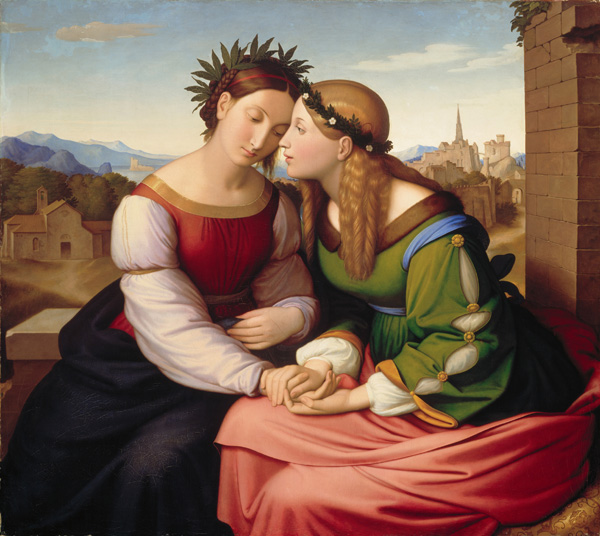Source

Source: Original: Neue Pinakothek, Bavarian State Painting Collections, Munich, Inv.-Nr. WAF 755. Available online at: https://www.pinakothek.de/kunst/meisterwerk/friedrich-overbeck/italia-und-germania
In 1810, around the same time that Friedrich Overbeck (1789–1869) painted a portrait of his close friend and fellow Nazarene Franz Pforr (1788–1812), the two artists embarked on a collaborative project that aimed to weave the threads of their personal relationship into a complicated tapestry of Romantic fable, allegory, and aesthetic manifesto. Each of the two was to paint a picture that at once embodied their friendship and their common artistic ideals. Pforr’s painting, Shulamit and Maria (1811), was a medieval-style diptych completed shortly before he died of tuberculosis in 1812. It introduced the two competing sources of Nazarene inspiration, the serene art of the early Italian Renaissance and the pious, contemplative painting of the artists’ native Northern Europe, in form of two female allegorical figures. In the guise of a Raphaelite Madonna, Shulamit sits in a walled garden in a classical, Mediterranean landscape, while Maria sits alone in a Flemish interior, contemplating her hair and a book of hours.
Overbeck did not complete his version of the friendship allegory at the time. When he returned to it years later, he transformed Pforr’s Shulamit and Maria into two new female figures representing the abstract national ideals of Italia and Germania. United in a single canvas, the two women are situated within a fictional landscape containing both a Germanic town, complete with a Gothic church spire, and a simple monastery straight out of the Roman countryside. Germania, who clasps one of Italia’s hands in both of hers and leans her entire body forward to meet Italia’s gentle, impassive nod, seems to be the far more urgent and needy friend. This impression is borne out in a letter Overbeck wrote to an art dealer in 1829, in which he explains that one of his intentions was to portray the “yearning…that constantly pulls the north toward the south, the yearning for its art, its nature, its poetry…” [“Es ist endlich…die Sehnsucht gemeint, die den Norden beständig zum Süden hinzieht, nach seiner Kunst, seiner Natur, seiner Poesie;” quoted in Jürgen Gläsemer, Traum und Wahrheit: Deutsche Romantik aus Museen der Deutschen Demokratischen Republik, exh. cat. Berne, 1985.]
Throughout the 18th and 19th centuries, it was commonly held that the introspective, spiritual, melancholy Northern artist longed for the unencumbered pleasure and warmth of southern climes. In his History of Ancient Art (1764), neoclassical art theorist Johann Joachim Winckelmann proposed that the development of classical form was at least partially attributable to the fact that the ancients were blessed with a warm climate and were thus able to observe the natural beauty of the unclothed human form as it engaged in athletic activity. Over a hundred years later, in The Case of Wagner (1888), the philosopher Friedrich Nietzsche contrasted the music of Richard Wagner to Georges Bizet’s Spanish-inspired opera Carmen. The latter, he claimed, allowed the spirit to soar because it was forged under the warm, blue sky of the Mediterranean, while the former was cold, wet, and typically Teutonic. In the intervening period, countless German artists, writers, and musicians followed in the footsteps of Goethe’s Italian Journey and were inspired by the myth of Italy.

Source: Original: Neue Pinakothek, Bavarian State Painting Collections, Munich, Inv.-Nr. WAF 755. Available online at: https://www.pinakothek.de/kunst/meisterwerk/friedrich-overbeck/italia-und-germania
© Photo: Joachim Blauel - ARTOTHEK